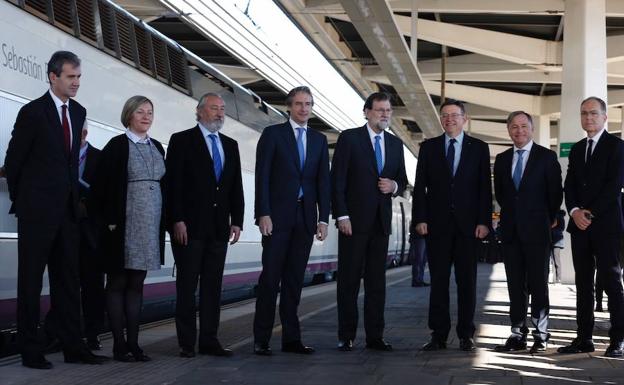The President of the Government, Mariano Rajoy, has inaugurated the AVE Madrid-Castellón, which will connect the two capitals in just over two and a half hours from this Tuesday.
Rajoy, who has traveled in the inaugural convoy together with the President of the Generalitat, Ximo Puig, and the Minister of Public Works, Íñigo de la Serna, has committed the Government’s support to the Mediterranean corridor and has indicated that the works have the necessary financing . “The works have an investment of 22,000 million of which we have already committed 62%,” he said.
The inaugural trip between Valencia and Castellón has suffered a delay of just over half an hour due to a problem in changing needles. The train has been stopped about 20 minutes between Sagunto and Puçol.
The Prime Minister, Mariano Rajoy, and the head of the Consell, Ximo Puig, have led the delegation of authorities that made the inaugural journey of the AVE that connects Madrid with Castellón this morning. Rajoy and the Minister of Public Works, Íñigo de la Serna, left at 9:25 a.m. from the Atocha station in Madrid on the AVE Juan Sebastián Elcano train that arrived at the Joaquín Sorolla station in Valencia at 10:08 a.m.
The Chief Executive got off the train to greet the authorities who were waiting for him there: Puig, the Government delegate in the Valencian Community, Juan Carlos Moragues, and the Valencian Minister of Housing, Public Works and Vertebration of the Territory, María José Salvador .
After a joint photo, all of them got on the train to make the opening tour. Valencian businessmen Juan Roig and Vicente Boluda also got on the train, who met with Mariano Rajoy and Ximo Puig during the journey.
Technical stop and reduced gear
At 11.55, the convoy stopped in the vicinity of Parc Sagunt, where it remained for about 20 minutes. The train stopped before reaching the Sagunto station without the journalists knowing at first what the specific reasons for this stop were. At about 12:15 p.m., the unit restarted. After the stop, those responsible for Renfe have reported that the delay has been due to an interlocking problem, a problem in the change of needles. After restarting the march, the AVE has circulated at reduced speed until reaching Sagunto. The AVE entered the Castellón station for the first time, a little more than half an hour late.
The President of the Government has considered the implementation of the AVE to Castellón as a milestone in the development of the Mediterranean Corridor and one more step in structuring the country. Rajoy has explained details of the new AVE service and stressed that the journey between Madrid and Castellón is reduced in 37 minutes, leaving it in two and a half hours. As proof of acceptance, it has reported that in just five days of marketing, 4,700 tickets have already been sold
However, both from the Government of the Valencian Community and from the parties that comprise it have been criticized in recent days on the occasion of this launch. Thus, the director general of Public Works, Transport and Mobility of the Valencian Government, Carlos Domingo, has assured that the AVE to Castellón “arrives late and badly after many breaches and damaging the Cercanías service.” He has considered this infrastructure one more example of the “evident lack of interest and improvisation of the Government in the Valencian Community” and has regretted that the AVE does not earn much compared to the previous Alvia because they have to circulate practically like the Cercanías trains in this section .
The socialists have also criticized the “non-compliance” of the Government with high speed because it will take longer than the time initially promised, and Compromís has decided not to attend this inauguration because it considers that Castellón “does not get high speed” but “the umpteenth botch of the Government “in the Valencian Community.
In front of it, the president of the Popular Party of the Valencian Community, Isabel Bonig, has affirmed that the arrival of the AVE to Castellón “is a reality thanks to the PP Government” and has regretted the “tantrums” of Compromís. For his part, the delegate of the Government in the Community has considered today’s event “historical” and has accused “Compromís” of “rudeness” and “disloyalty” towards the Government and of “promoting frentismo” for not attending that inaugural act .
Three new sections of the A7
Rajoy has also taken advantage of his visit to announce other actions in the field of infrastructure in the Valencian Community and specifically in Castellón. In this context, he announced that the second project of the Extraordinary Road Investment Plan, which will mobilize 5,000 million euros throughout Spain creating 189,000 jobs, will directly benefit Castellón.
Specifically, he has reported that three new sections of the A7 of the Mediterranean will be built in this province from Vilanova de Alcolea to La Jana with a triple objective: to enhance the Mediterranean Corridor, help the structuring of the interior of Castellón and improve the connectivity with Aragon.
With an investment of 434 million euros, this action will have a length of almost 48 kilometers and will continue the itinerary of the CV10 motorway, allowing the closure of the A-7 Mediterranean motorway in the province of Tarragona in the future. The intention is to tender this action by releasing the feasibility study next fall for public information.
SOURCE: LAS PROVINCIAS.ES


